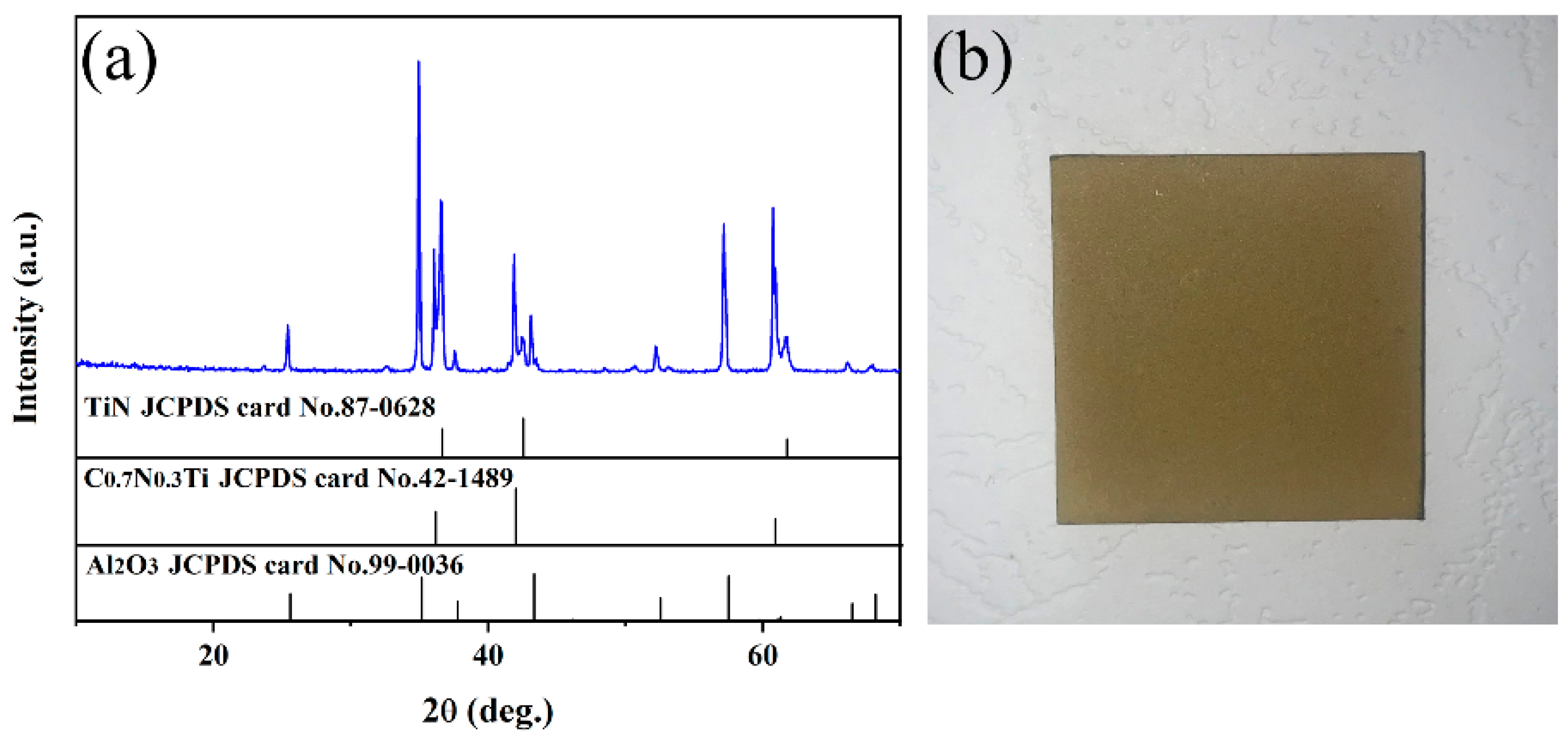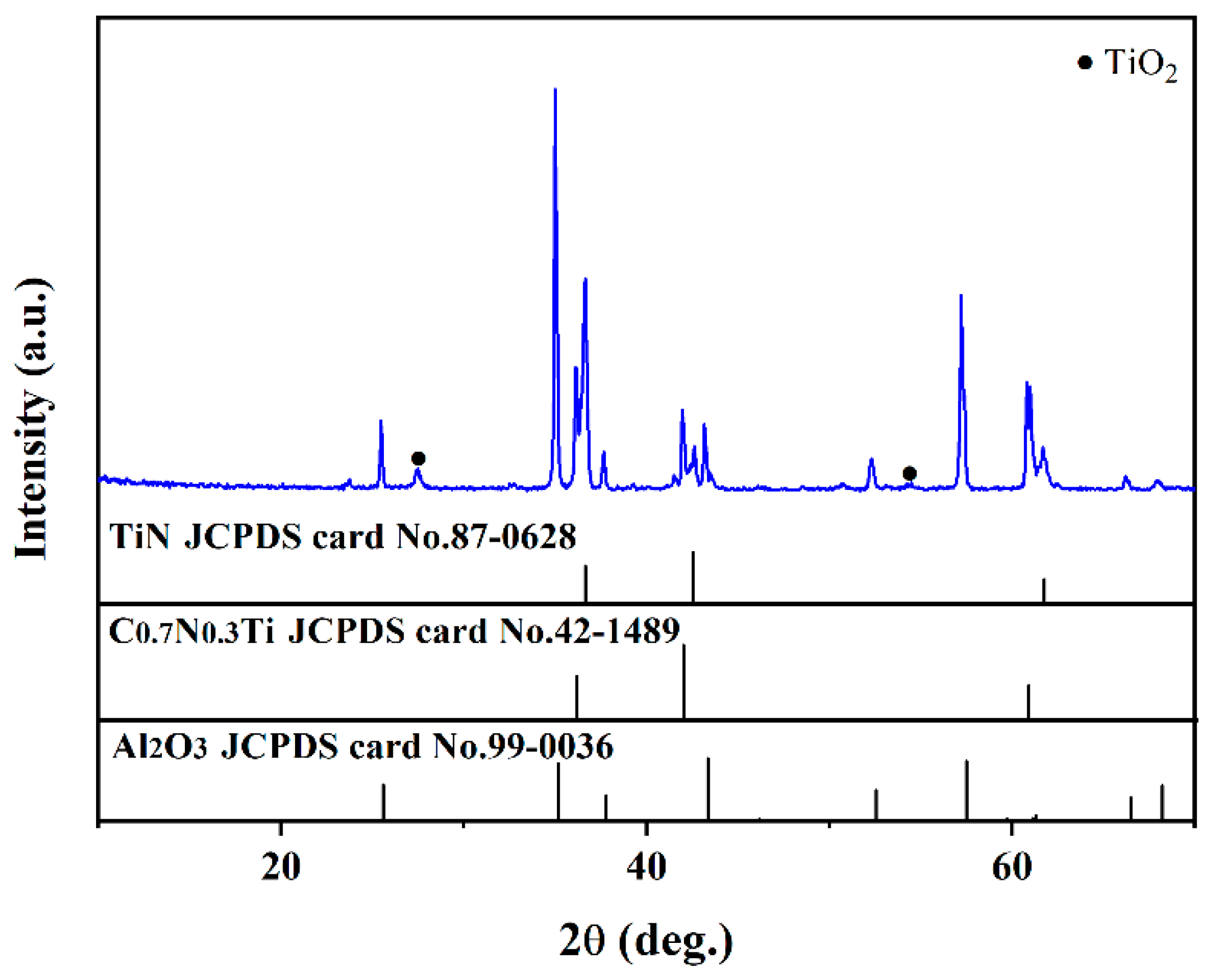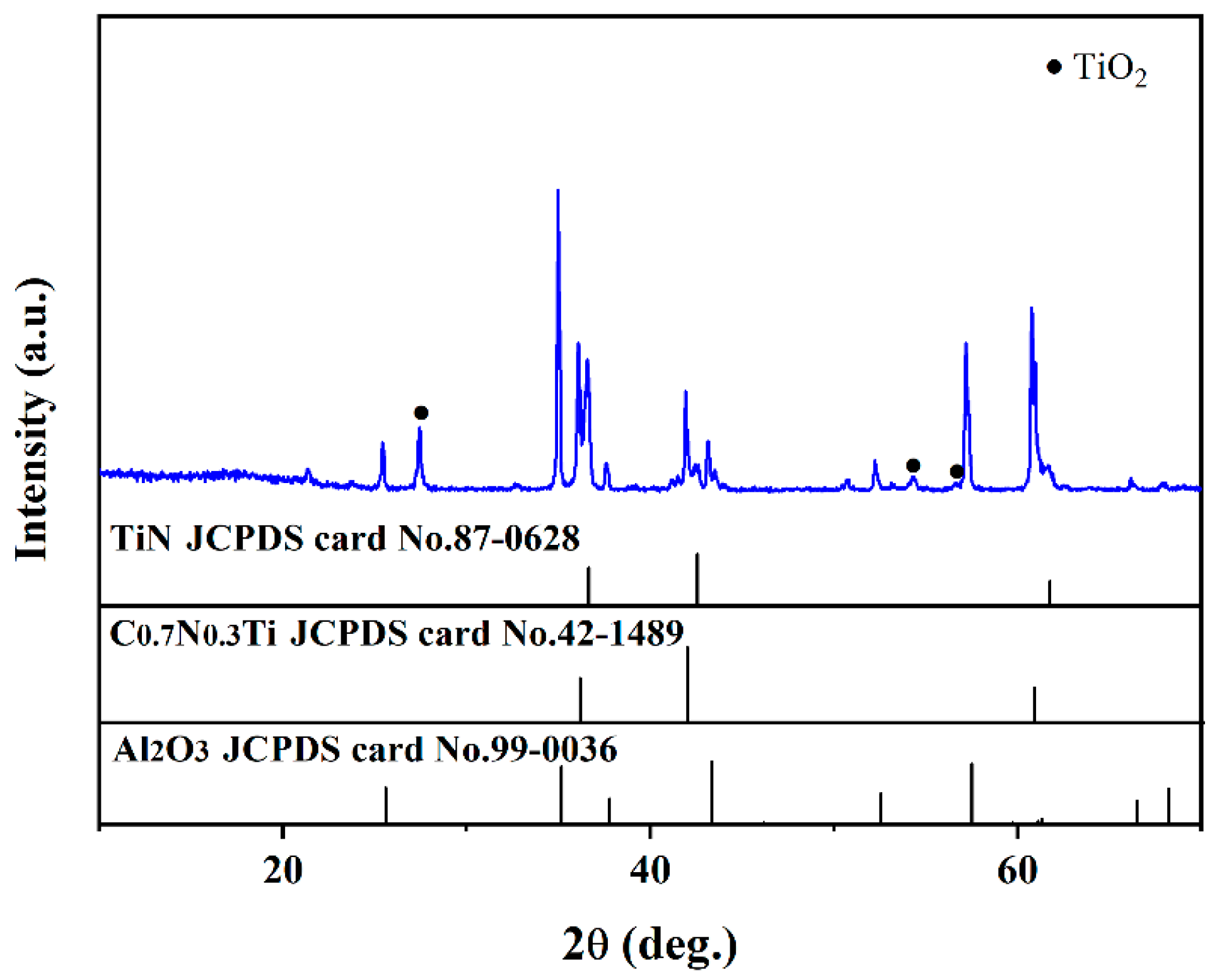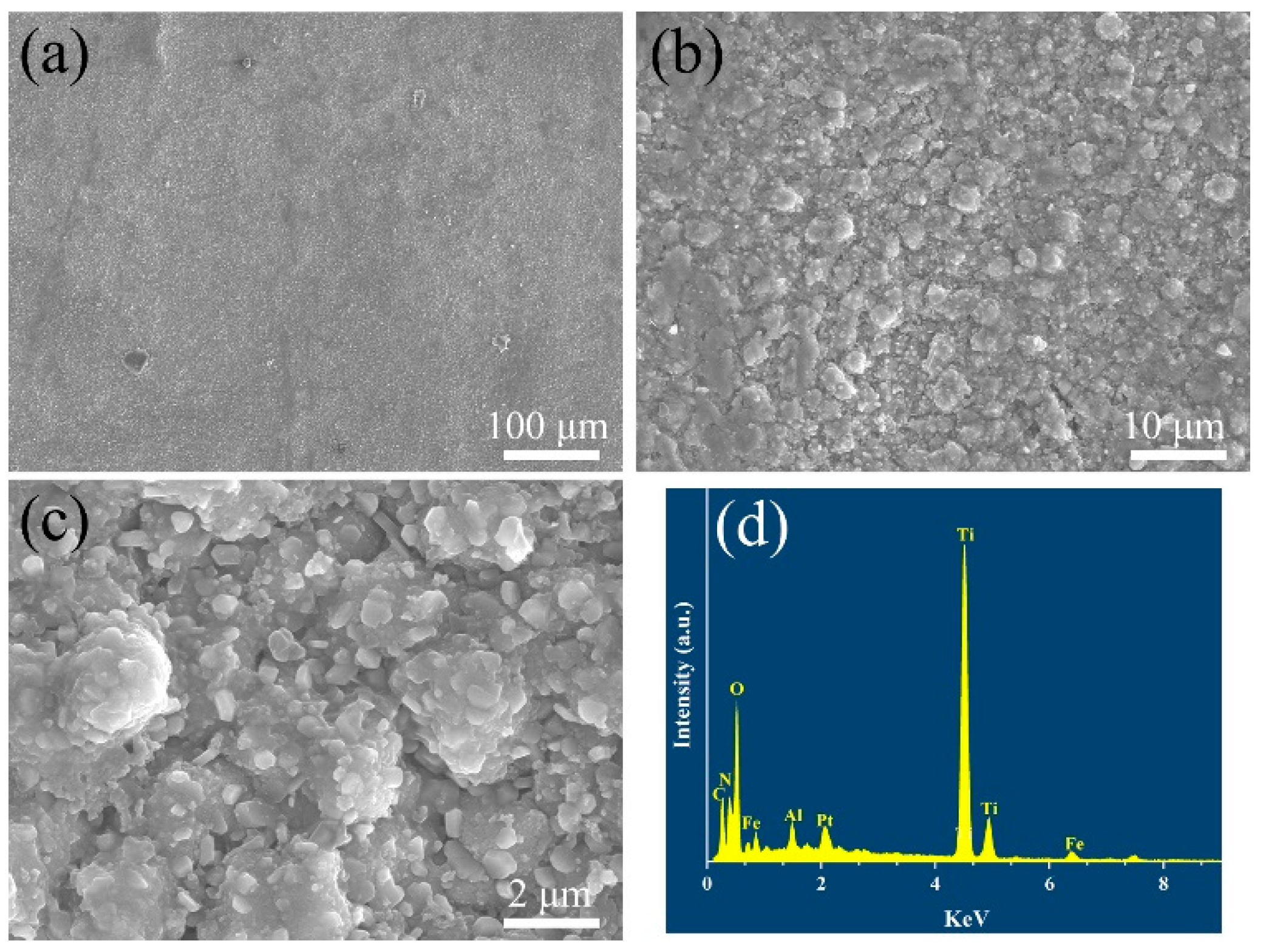Fabrication and Supercritical Water Corrosion Resistance of TiN/TiNC/Al2O3 Multilayer Coating on Inconel 625 Alloy by CVD Method
Abstract
:1. Introduction
2. Experimental Section
2.1. Materials and Sample Preparation
2.2. Characterization
3. Results
3.1. Characterization of the TiN/TiNC/Al2O3 Coating
3.2. Characterization after Supercritical Water Oxidation Test without Oxygen
3.3. Characterization after Supercritical Water Oxidation Test with Oxygen
4. Conclusions
Author Contributions
Funding
Institutional Review Board Statement
Informed Consent Statement
Conflicts of Interest
References
- Squarer, D.; Schulenberg, T.; Struwe, D.; Oka, Y.; Bittermann, D.; Aksan, N.; Maraczy, C.; Kyrki-Rajamäki, R.; Souyri, A.; Dumaz, P. High performance light water reactor. Nucl. Eng. Des. 2003, 221, 167–180. [Google Scholar] [CrossRef]
- Correa, C.R.; Kruse, A. Supercritical water gasification of biomass for hydrogen production—Review. J. Supercrit. Fluids 2018, 133, 573–590. [Google Scholar] [CrossRef]
- Zhang, S.; Zhang, Z.; Zhao, R.; Gu, J.; Liu, J.; Örmeci, B.; Zhang, J. A Review of Challenges and Recent Progress in Supercritical Water Oxidation of Wastewater. Chem. Eng. Commun. 2017, 204, 265–282. [Google Scholar] [CrossRef]
- Yang, J.; Wang, S.; Li, Y.; Zhang, Y.; Xu, D. Novel design concept for a commercial-scale plant for supercritical water oxidation of industrial and sewage sludge. J. Environ. Manag. 2019, 233, 131–140. [Google Scholar] [CrossRef] [PubMed]
- Tang, X.; Wang, S.; Qian, L.; Li, Y.; Lin, Z.; Xu, D.; Zhang, Y. Corrosion behavior of nickel base alloys, stainless steel and titanium alloy in supercritical water containing chloride, phosphate and oxygen. Chem. Eng. Res. Des. 2015, 100, 530–541. [Google Scholar] [CrossRef]
- Guo, S.; Xu, D.; Li, Y.; Guo, Y.; Wang, S.; Macdonald, D.D. Corrosion characteristics and mechanisms of typical Ni-based corrosion-resistant alloys in sub- and supercritical water. J. Supercrit. Fluids 2015, 170, 105138. [Google Scholar] [CrossRef]
- Sarrade, S.; Féron, D.; Rouillard, F.; Perrin, S.; Robin, R.; Ruiz, J.-C.; Turc, H.-A. Overview on corrosion in supercritical fluids. J. Supercrit. Fluids 2017, 120, 335–344. [Google Scholar] [CrossRef]
- Tang, X.; Wang, S.; Xu, D.; Gong, Y.; Zhang, J.; Wang, Y. Corrosion Behavior of Ni-Based Alloys in Supercritical Water Containing High Concentrations of Salt and Oxygen. Ind. Eng. Chem. Res. 2013, 52, 18241–18250. [Google Scholar] [CrossRef]
- Marrone, P.A.; Hong, G.T. Corrosion control methods in supercritical water oxidation and gasification processes. J. Supercrit. Fluids 2009, 51, 83–103. [Google Scholar] [CrossRef]
- Sun, C.; Hui, R.; Qu, W.; Yick, S. Progress in corrosion resistant materials for supercritical water reactors. Corros. Sci. 2009, 51, 2508–2523. [Google Scholar] [CrossRef]
- Zhang, S.; Zhu, W. TiN coating of tool steels: A review. J. Mater. Process. Technol. 1993, 39, 165–177. [Google Scholar] [CrossRef]
- Kobayashi, A. Formation of TiN coatings by gas tunnel type plasma reactive spraying. Surf. Coat. Technol. 2000, 132, 152–157. [Google Scholar] [CrossRef]
- Bacci, T.; Bertamini, L.; Ferrari, F.; Galliano, F.P.; Galvanetto, E. Reactive plasma spraying of titanium in nitrogen containing plasma gas. Mater. Sci. Eng. A 2000, 283, 189–195. [Google Scholar] [CrossRef]
- Shieu, F.S.; Cheng, L.H.; Sung, Y.C.; Huang, J.H.; Yu, G.P. Microstructure and coating properties of ion-plated TiN on type 304 stainless steel. Thin Solid Films 1998, 334, 125–132. [Google Scholar] [CrossRef]
- Khatkhatay, F.; Jiao, L.; Jian, J.; Zhang, W.; Jiao, Z.; Gan, J.; Zhang, H.; Zhang, X.; Wang, H. Superior corrosion resistance properties of TiN-based coatings on Zircaloy tubes in supercritical water. J. Nucl. Mater. 2014, 451, 346–351. [Google Scholar] [CrossRef]
- Tsai, W.-T.; Huang, K.-E. Microstructural aspect and oxidation resistance of an aluminide coating on 310 stainless steel. Thin Solid Films 2000, 366, 164–168. [Google Scholar] [CrossRef]
- Gong, X.; Wang, B.; Han, H.; Kang, T.; Zhu, Q.; Wang, J.; Li, X. Preparation of Al2O3 coating on TiN coating by polymer-assisted deposition to improve oxidation resistance in coking inhibition applications. Ceram. Int. 2020, 46, 7774–7782. [Google Scholar] [CrossRef]







Publisher’s Note: MDPI stays neutral with regard to jurisdictional claims in published maps and institutional affiliations. |
© 2022 by the authors. Licensee MDPI, Basel, Switzerland. This article is an open access article distributed under the terms and conditions of the Creative Commons Attribution (CC BY) license (https://creativecommons.org/licenses/by/4.0/).
Share and Cite
Zhang, Z.; Pan, Y.; Guo, H.; Zeng, X.; Shi, Q.; Lu, T. Fabrication and Supercritical Water Corrosion Resistance of TiN/TiNC/Al2O3 Multilayer Coating on Inconel 625 Alloy by CVD Method. Materials 2022, 15, 7670. https://doi.org/10.3390/ma15217670
Zhang Z, Pan Y, Guo H, Zeng X, Shi Q, Lu T. Fabrication and Supercritical Water Corrosion Resistance of TiN/TiNC/Al2O3 Multilayer Coating on Inconel 625 Alloy by CVD Method. Materials. 2022; 15(21):7670. https://doi.org/10.3390/ma15217670
Chicago/Turabian StyleZhang, Zhidong, Yuelong Pan, Hao Guo, Xiangcai Zeng, Qiwu Shi, and Tiecheng Lu. 2022. "Fabrication and Supercritical Water Corrosion Resistance of TiN/TiNC/Al2O3 Multilayer Coating on Inconel 625 Alloy by CVD Method" Materials 15, no. 21: 7670. https://doi.org/10.3390/ma15217670



